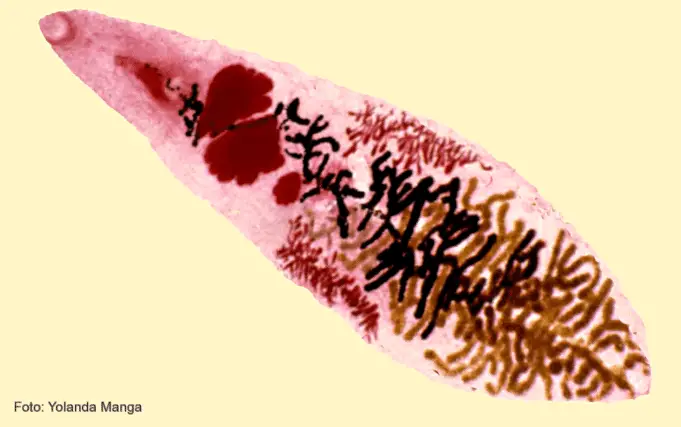Food and water consumed by humans can sometimes be contaminated with both living and non-living materials which have adverse effects on our health.
These include viruses, bacteria and chemical contaminants. Many factors are responsible for these infections; whether the processing or preparation of the food or by its storage.
Trematodes, also known as flukes, are parasitic flatworms typically appear as leaflike. Its class contains about 6000 species of trematodes and are found all over the world and depend on their survival using specialized organs to hold onto their hosts.
Some species of trematodes typically use muscular oral or ventral suckers to attach themselves to their hosts. In contrast, others like those belonging to the subclass Aspidogastrea possess large ventral disks they use for adhesion.
Trematode infections, also known as trematodiases, are a group of diseases caused by these parasites. They are characterized by symptoms that can be mild or severe depending on the trematode species, number, and the location of the trematodes in the infected host.
Symptoms include shortness of breath, loss of appetite, high temperature, and chest and abdominal pain. These parasitic organisms can be transmitted by food and water.
Aquatic organisms such as fish, frogs, shellfish, snails, snakes and water plants often act as the primary hosts of the trematodes until maturity. Transmission by food occurs when an infected person consumes undercooked and contaminated aquatic plants and animals.
It has been estimated that about 750 million people are at risk of infections with food-borne trematodes. Examples of trematodes include intestinal flukes (e.g., Echinostoma spp., Fasciolopsis buski, and the heterophyids), liver flukes (Clonorchis sinensis, Fasciola gigantica, Fasciola hepatica, Opisthorchis felineus, and Opisthorchis viverrini), and lung flukes (Paragonimus westermani.).
These can be classified as Neglected Tropical Diseases (NTD); they pose a significant health challenge and economic problem to communities, yet they are often neglected.
Cases of food-borne trematodes can be found in about 70 countries around the world, with the majority being in Latin America and Asia.
Food-borne trematodes can be prevented and controlled by public health schemes with the aim of educating people about how contaminated food and water can lead to infections.
Types of Food-borne Trematodes
Liver Flukes
These are a group of parasitic trematodes belonging to the phylum Platyhelminthes. They are parasites that primarily affect the liver of several mammals, including humans.
They are capable of moving in the bloodstream and can also occur in the gallbladder, bile ducts and the liver parenchyma where they produce lesions leading to diseases. Liver flukes have a life cycle that requires two or three hosts.
Liver flukes have leaflike and flattened shape and are hermaphrodites having complete sets of both male and female reproductive systems. Their digestive systems are quite simple, and they feed primarily on blood.
Their eggs infect snails where they grow into larvae which are released into the environment. The released larvae further infect the mammalian hosts. Sometimes humans directly consume the infected aquatic organisms, making the liver flukes food-borne parasites.
Examples of liver flukes include Clonorchis sinensis (the Chinese liver fluke, or the Oriental liver fluke), Dicrocoelium dendriticum (the lancet liver fluke), Fasciola hepatica (the sheep liver fluke Fascioloides magna (the giant liver fluke), Fasciola gigantica, Fasciola jacksoni, Metorchis conjunctus.
Intestinal Flukes
Intestinal flukes often show little to no symptoms, although this depends on the number of parasites in the infected host.
Light infections of intestinal flukes such as Fasciolopsis buski are characterized by mild symptoms of headache, constipation, diarrhoea, abdominal pain, and dizziness. In severe cases, diarrhoea, vomiting, colic, fever, allergic reactions can occur.
Heavy infections of F. buski can be fatal as the parasite can erode the intestinal walls and cause ulcer, haemorrhages and inflammation.
Lung Flukes
Paragonimus westermani, also known as Japanese lung fluke or oriental lung fluke, is the dominant species of food-borne trematodes affecting human lungs.
Transmission of this parasite in mammals occurs primarily through the consumption of raw or undercooked seafood. Accidental transfer of the infective cysts can happen when handling raw food by food preparers.
The consumption of animals that feed on infected crustaceans like crabs can also transmit the parasite. Symptoms of P. westermani include diarrhoea, abdominal pain, fever, cough, and itching.
The parasite may later damage the lungs and other organs such as the skin. Infected persons may develop chronic cough and chest pain, and may have difficulty breathing. The parasite can also affect the brain and cause seizures or eye problems.
Infected persons may even be paralyzed.
Diagnosis of Food-borne Trematodes
Food-borne trematodes can be detected through a number of methods. These include:
- Lab tests to detect the presence of trematode eggs in fecal samples of infected hosts.
- Test for antibodies that are produced by the host’s immune system when infected.
- Molecular diagnosis using methods such as polymerase chain reactions and pyrosequencing which detects the parasites’ DNA in samples obtained from infected persons.
- Ultrasounds, CT scans and X-rays that detect specific species of trematodes.
Treatment, Prevention and Control
Public health programs and interventions help to prevent and control the prevalence, transmission, and morbidity of food-borne trematodes include:
- Improved access to adequate sanitation
- Education and awareness of communities on the dangers of food-borne trematodes and how to prevent them.
- Use of chemical fertilizers
- Chemotherapy
There are currently no vaccines available for the treatment of food-borne trematodes. Information and education campaigns aim to chain human behavior in regards to the consumption and preparation of raw or undercooked aquatic products.












